

Teaching empathy through Design Thinking. In an age of creators, makers, and innovators, we hear of the concept design thinking too often.

What is design thinking? More importantly, can design thinking help you as an educator in your classroom? Design thinking is a concept that centers around applying creativity and innovation to our actions, decision making, and problem solving as human beings. More significantly, it focuses on the impact that this creative and innovative thinking has on individuals. As a concept, design thinking can be used pedagogically to enhance our teaching practices. How (And Why) Teachers Should Blog. Blogs have the potential to expand student creativity, not to mention their writing skills.

Language Arts and Reading specialists will love that, right? But how do I convince them that their students are thirsty for the knowledge they want to share but not the same way that they themselves obtained it? These kids are 21st century students and are adapting to a digital world that they are eager to learn from. Fortunately for teachers, blogs are surprisingly easy to use. Making Student Data Part of the Conversation. When Cole Young became the principal of Humboldt Elementary School 12 years ago, the school was only 300ths of a point away from being labeled under-performing.
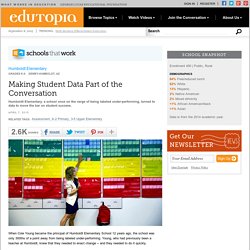
Young, who had previously been a teacher at Humboldt, knew that they needed to enact change -- and they needed to do it quickly. Young, who says he'd "been a numbers guy for a long time," began aggregating all kinds of data, pushing it out to the teachers and staff, and exploring the role it could play in helping the school turn the tables on its under-performing label. Twelve years later, the result is a school that uses data in myriad ways and is truly data driven. Creating A Data-Friendly Culture In moving Humboldt Elementary to a more data-driven model, one of the first challenges that former principal Cole Young faced was figuring out how to use the data, how to share it, and how to get everyone on the same page with the numbers.
Making It Collaborative, Not Competitive Tools of the Trade. Meta-Collaboration: Thinking With Another. What if we could dramatically improve our thought processes and learning strategies by tapping into the social genius of another?
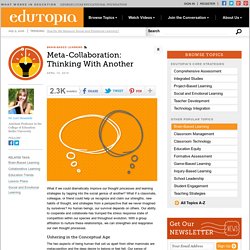
What if a classmate, colleague, or friend could help us recognize and claim our strengths, new habits of thought, and strategies from a perspective that we never imagined by ourselves? As human beings, our survival depends on others. Our ability to cooperate and collaborate has trumped the stress response state of competition within our species and throughout evolution. With a group affiliation to nurture these relationships, we can strengthen and reappraise our own thought processes. Ushering in the Conceptual Age The two aspects of being human that set us apart from other mammals are metacognition and the deep desire to belong or feel felt. Strategies for Helping Students Motivate Themselves. Editor's Note: This piece was adapted from Building a Community of Self-Motivated Learners: Strategies to Help Students Thrive in School and Beyond by Larry Ferlazzo, available March 21, 2015 from Routledge.
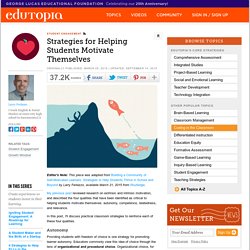
My previous post reviewed research on extrinsic and intrinsic motivation, and described the four qualities that have been identified as critical to helping students motivate themselves: autonomy, competence, relatedness, and relevance. In this post, I'll discuss practical classroom strategies to reinforce each of these four qualities. Autonomy Providing students with freedom of choice is one strategy for promoting learner autonomy.
Educators commonly view this idea of choice through the lens of organizational and procedural choice. Epic Fail or Win? Gamifying Learning in My Classroom. Creating the Conditions for Student Motivation. Editor's Note: This piece was adapted from Building a Community of Self-Motivated Learners: Strategies to Help Students Thrive in School and Beyond by Larry Ferlazzo, available March 21, 2015 from Routledge.
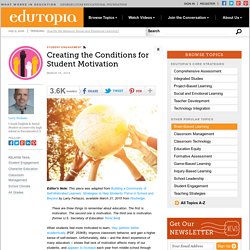
There are three things to remember about education. The first is motivation. The second one is motivation. The third one is motivation. (former U.S. When students feel more motivated to learn, they perform better academically (PDF, 253KB), improve classroom behavior, and gain a higher sense of self-esteem. 4 Ways to Turn Distracted Students into Engaged Learners. Seven out of 10 academic leaders agree that online learning is critical to the future of education.
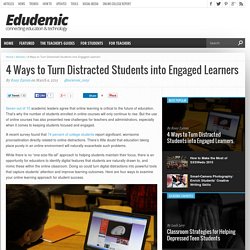
A Very Good Critical Thinking Framework for Teachers and Educators. Who Wants to Know? Use Student Questions to Drive Learning. Martin Luther King, Jr. considered this to be life's most persistent and urgent question: "What are you doing for others?

" As we approach the holiday that honors his legacy, here's another question worth pondering: How many of your students know how to ask persistent and urgent questions of their own? Knowing how to formulate a good question -- and having the courage to ask it -- is a skill with profound social justice implications. Dan Rothstein and Luz Santana, founders of the Right Question Institute, first became interested in questioning techniques when they were working with parents in a low-income community. Parents told them they didn't participate in their children's education because they didn't know what to ask. That was more than 20 years ago. 11 Traits of Effective Teachers. January 2, 2015 I am not sure if you have already read it or not but this is one of the most popular posts by Edutopia in 2014.
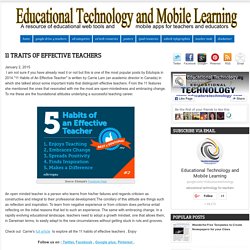
"11 Habits of An Effective Teacher" is written by Carrie Lam (an academic director in Canada) in which she talked about some important traits that distinguish effective teachers. From the 11 features she mentioned the ones that resonated with me the most are open-mindedness and embracing change. To me these are the foundational attitudes underlying a successful teaching career. The Agile Classroom. Agile development refers to an iterative and highly collaborative approach to creating a product.
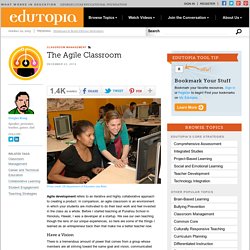
In comparison, an agile classroom is an environment in which your students are motivated to do their best work and feel invested in the class as a whole. Before I started teaching at Punahou School in Honolulu, Hawaii, I was a developer at a startup. We see our own teaching though the lens of our unique experiences, so here are some of the things I learned as an entrepreneur back then that make me a better teacher now. Have a Vision There is a tremendous amount of power that comes from a group whose members are all striving toward the same goal and vision, communicated from the top, a goal and vision guiding the team members' daily decisions.
Create a self-sustaining community that reinforces trust between individuals and rewards pro-social behavior. 26 Questions to Ask Students in The First Week of School. August 12, 2014 Today as I was browsing through my Twitter feeds I stumbled upon this list of questions every student should be able to answer. 5 Proven Ways to Engage Students In Your Classroom.
The eyes roll back, the mouth scowls, the fingers grip the not-so-secretly hidden cellphone, and the brain checks out. These are, as teachers everywhere can attest, the surefire signs of a disengaged student. And these symptoms are ravaging the educational system. Teachers know that student engagement is the key to learning retention and having a great overall classroom experience, but they often don’t have the time or energy to come up with some of the outrageous things that they see other teachers doing online to keep kids’ interest.